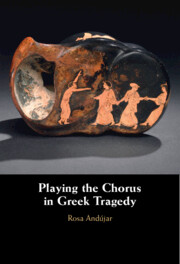Refine search
Actions for selected content:
37 results
Chapter 2 - Augmenting the Chorus
-
- Book:
- Playing the Chorus in Greek Tragedy
- Published online:
- 23 October 2025
- Print publication:
- 06 November 2025, pp 96-153
-
- Chapter
- Export citation
Chapter 3 - Interrupting the Chorus
-
- Book:
- Playing the Chorus in Greek Tragedy
- Published online:
- 23 October 2025
- Print publication:
- 06 November 2025, pp 154-214
-
- Chapter
- Export citation
Introduction
-
- Book:
- Playing the Chorus in Greek Tragedy
- Published online:
- 23 October 2025
- Print publication:
- 06 November 2025, pp 1-25
-
- Chapter
- Export citation

Playing the Chorus in Greek Tragedy
-
- Published online:
- 23 October 2025
- Print publication:
- 06 November 2025
Building AI competence in the healthcare workforce with the AI for clinical care workshop: A Bridge2AI for clinical CHoRUS project
-
- Journal:
- Journal of Clinical and Translational Science / Volume 9 / Issue 1 / 2025
- Published online by Cambridge University Press:
- 03 October 2025, e243
-
- Article
-
- You have access
- Open access
- HTML
- Export citation
Introduction
-
- Book:
- Athens, 403 BC
- Published online:
- 28 February 2025
- Print publication:
- 20 March 2025, pp 1-30
-
- Chapter
- Export citation
Chapter 4 - Socrates and the Voices of Neutrality
-
- Book:
- Athens, 403 BC
- Published online:
- 28 February 2025
- Print publication:
- 20 March 2025, pp 138-165
-
- Chapter
- Export citation
Conclusion
-
- Book:
- Athens, 403 BC
- Published online:
- 28 February 2025
- Print publication:
- 20 March 2025, pp 297-328
-
- Chapter
- Export citation
Chapter 1 - Critias and the Oligarchs
-
- Book:
- Athens, 403 BC
- Published online:
- 28 February 2025
- Print publication:
- 20 March 2025, pp 31-70
-
- Chapter
- Export citation
Chapter 5 - Natures and the Nonhuman in Horace’s Odes
-
- Book:
- The Environmental Poetry of Augustan Rome
- Published online:
- 12 December 2024
- Print publication:
- 19 December 2024, pp 180-227
-
- Chapter
- Export citation
Chapter 5 - From Agamemnon to Herakles
- from Part III - Tragedy and Translation in Late Modernism
-
- Book:
- Modernist Hellenism
- Published online:
- 21 November 2024
- Print publication:
- 28 November 2024, pp 247-284
-
- Chapter
- Export citation
7 - Stompbox Revolution: Electric Guitar Pedals and Tone
- from Part II - Technology and Timbre
-
-
- Book:
- The Cambridge Companion to the Electric Guitar
- Published online:
- 08 November 2024
- Print publication:
- 17 October 2024, pp 111-128
-
- Chapter
- Export citation
5 - Heads or Tails
-
- Book:
- Centaurs and Snake-Kings
- Published online:
- 16 August 2024
- Print publication:
- 25 July 2024, pp 136-170
-
- Chapter
- Export citation
6 - Philoctetes
-
- Book:
- Helping Friends and Harming Enemies
- Published online:
- 06 June 2024
- Print publication:
- 13 June 2024, pp 184-225
-
- Chapter
- Export citation
7 - “All Together, Now”? Ensembles and Choruses in The Magic Flute
- from Part II - Music, Text, and Action
-
-
- Book:
- The Cambridge Companion to <i>The Magic Flute</i>
- Published online:
- 24 November 2023
- Print publication:
- 02 November 2023, pp 119-131
-
- Chapter
- Export citation
Afterword
-
-
- Book:
- Shakespeare at War
- Published online:
- 17 August 2023
- Print publication:
- 17 August 2023, pp 255-257
-
- Chapter
- Export citation
2 - The Substance of Song: Music in Homer and the Homeric Hymns
- from Part I - Bodies
-
- Book:
- Greek Poetry in the Age of Ephemerality
- Published online:
- 02 June 2023
- Print publication:
- 27 April 2023, pp 69-96
-
- Chapter
- Export citation
Chapter 5 - Lean on Me
-
- Book:
- The Masculinities of John Milton
- Published online:
- 01 September 2022
- Print publication:
- 08 September 2022, pp 145-173
-
- Chapter
- Export citation
Chapter 2 - The Chorus of the Agamemnon
-
- Book:
- Beyond Death in the <i>Oresteia</i>
- Published online:
- 01 September 2022
- Print publication:
- 08 September 2022, pp 51-68
-
- Chapter
-
- You have access
- Open access
- HTML
- Export citation
Chapter 12 - ‘All Their Minds Transfigured So Together’: The Imagination at the Elizabethan Playhouse
- from Part III - Playhouses
-
-
- Book:
- Playing and Playgoing in Early Modern England
- Published online:
- 10 March 2022
- Print publication:
- 17 March 2022, pp 242-261
-
- Chapter
- Export citation
